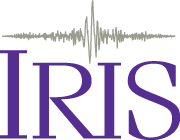Organization:IRIS Consortium
 | |
| Motto | World leader in advancing discovery, research, and education in seismology. |
|---|---|
| Founded | October 1984 |
| Type | 501(c)(3) |
| Location | |
| Services | Research, Education |
Members | 290 (2018) |
Official languages | English |
Key people | Robert Detrick, President |
| Website | www |
IRIS (Incorporated Research Institutions for Seismology[1]) is a university research consortium dedicated to exploring the Earth's interior through the collection and distribution of seismographic data. IRIS programs contribute to scholarly research, education, earthquake hazard mitigation, and the verification of a Comprehensive Nuclear-Test-Ban Treaty. Support for IRIS comes from the National Science Foundation, other federal agencies, universities, and private foundations. IRIS supports five major components, the Data Management Center (DMC[2]), the Portable Array Seismic Studies of the Continental Lithosphere (PASSCAL[3]), the Global Seismographic Network (GSN[4]), the Transportable Array (USARRAY[5]), and the Education and Public Outreach Program (EPO[6]). IRIS maintains a Corporate Office in Washington, DC.
IRIS's Education and Public Outreach Program provides resources for educators and the general public to advance awareness and understanding of seismology and earth science while inspiring careers in geophysics by offering animations, videos, lessons, software, posters, and fact sheets.
IRIS is listed in the Registry of Research Data Repositories re3data.org.[7]
History
In 1959, the United States Government launched a research effort aimed at improving national capabilities to detect and identify foreign nuclear explosions detonated underground and at high altitudes. The resultant World Wide Standard Seismograph Network (WWSSN) was an amazingly successful program. It provided seismological data for its intended purpose as well as for the emerging concept of plate tectonics. Initially operated by the Defense Department, by 1973 operations were transferred to the U.S. Geological Survey. A collaboration with IRIS began in 1984 as a result of a need to expand and replace the WWSSN with the Global Seismic Network (GSN). The network, originally funded entirely by the USGS under the National Earthquake Hazards Reduction Program (NEHRP), is now jointly supported by the National Science Foundation.
See also
- Earthscope
- Geophysics
- Plate tectonics
- POLARIS
- Reflection seismology
- Seismology
- Seismometer
- Volcanology
References
- ↑ http://www.iris.edu
- ↑ http://ds.iris.edu/ds/nodes/dmc/
- ↑ http://www.iris.edu/hq/programs/passcal
- ↑ http://www.iris.edu/hq/programs/gsn
- ↑ http://www.usarray.org
- ↑ http://www.iris.edu/hq/programs/epo
- ↑ "IRIS Entry in re3data.org". http://service.re3data.org/repository/r3d100010268. Retrieved 21 August 2014.
- Smith, S., IRIS – A University Consortium for Seismology, Reviews of Geophysics and Space Physics, Vol. 25, p. 1203, 1986.
- "IRIS's About Page". Introduction. https://www.iris.edu/hq/about_iris.
- van der Vink GE (1998). "The role of seismologists in debates over the Comprehensive Test Ban Treaty". Annals of the New York Academy of Sciences 866: 84–113. doi:10.1111/j.1749-6632.1998.tb09148.x. PMID 12088011.
- Aster, R., Beaudoin, B., Hole, J., Fouch, M., Fowler, J., James, D., and the PASSCAL Staff and Standing Committee, IRIS PASSCAL program marks 20 years of scientific discovery, EOS trans. AGU, 86, 26 April 2005.
- Butler, R., Lay T., Creager, K., Earle, P., Fischer, K., Geherty, J., Laske, G., Leith, B., Park, J., Ritzwoller, M, Tromp, J., Wen, L., The Global Seismographic Network Surpasses Its Design Goal, EOS Trans. AGU., 85 (23) 225–232, 2004.
External links

